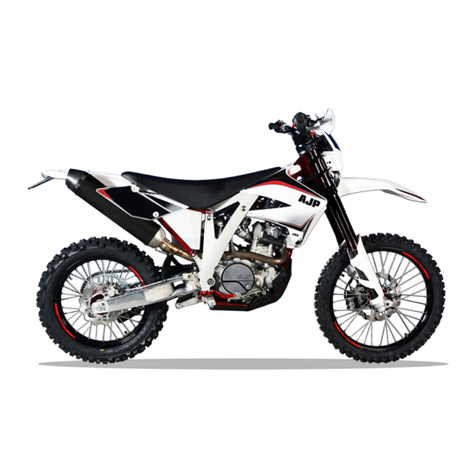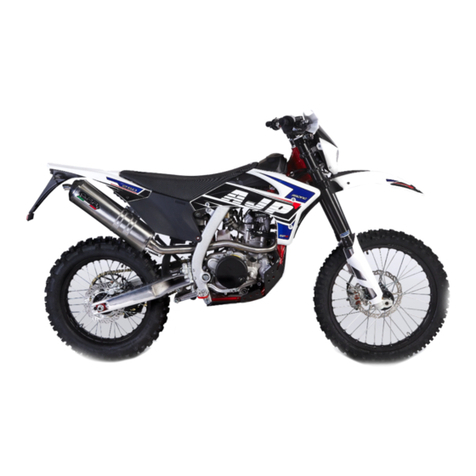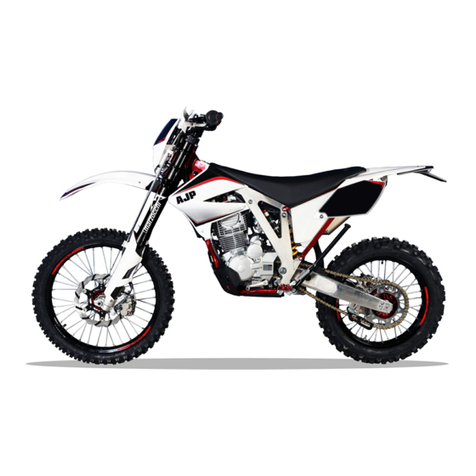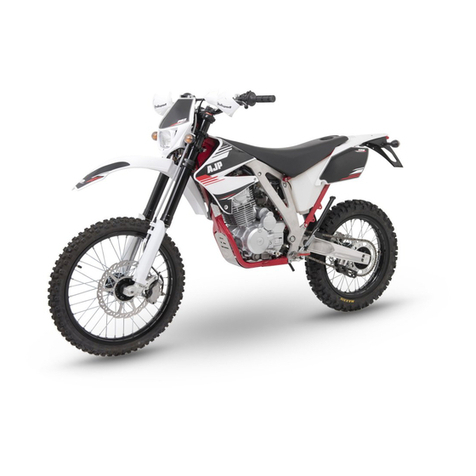AJP PR5 User’s manual – 2nd Edition Page
1
CONSUMER INFORMATION
ACCESSORY INSTALLATION AND
PRECAUTION SAFETY TIPS
There is some variety of accessories for
AJP motorcycles. AJP cannot have
direct control over the quality or
suitability of accessories you may want
to purchase. The addition of unsuitable
accessories can lead to unsafe
operating conditions. Please contact
your AJP dealer for assist you in
selecting accessories and install them
correctly.
Improper accessories or
modifications can make your
motorcycle unsafe and can lead to
an accident. Never modify the
motorcycle with improper or poorly
installed accessories. Follow all
instructions in this owner’s manual
regarding accessories and
modifications. Consult your AJP
dealer if you have any questions.
Certain accessories displace the rider
from his normal position. This limits the
freedom of movement and may limit his
control ability.
Additional electric accessories may
overload the electric system. Severe
overloads may damage the wiring
harness or create a dangerous situation
due to the loss of electric power during
the operation of the motorcycle.
When carrying a load on the
motorcycle, mount it as low as possible
to the machine. An improperly mounted
load can create a high center of gravity
that is very dangerous and makes the
motorcycle difficult to handle. The size
of the load can also affect the
aerodynamics and handling of the
motorcycle. Balance the load between
the left and right sides of the motorcycle
and fasten it securely.
SAFE RIDING RECOMMENDATIONS
FOR MOTORCYCLE RIDERS:
WEAR A HELMET
Motorcycle safety equipments starts
with a quality helmet. One of the most
serious injuries that can happen is a
head injury. ALWAYS wear a properly
approved helmet.
You should also wear suitable eye
protection.
RIDING APPAREL
Loose, fancy clothing can be
uncomfortable and unsafe for
motorcycle riding. Choose good quality
motorcycle riding apparel when riding
your motorcycle. Wear gloves, strong
boots that fit over the ankle, long pants
and long sleeve shirt or jacket.
INSPECTION BEFORE RIDING
Review all the instructions in the
“INSPECTION BEFORE RIDING”
section in this manual. Do not forget to
perform an entire safety inspection to
ensure safety of the rider.
FAMILIARIZE YOURSELF WITH THE
MOTORCYCLE
Your riding skill and your mechanical
knowledge form the basis for safe
riding. We recommend you to practice
riding your motorcycle in an open area
without obstacles until you are familiar
with your motorcycle and its controls.
KNOW YOUR OWN LIMITS
Always ride within the limits of your
skills. Knowing your limits and keep
within are the foundation to avoid
accidents and injuries.
BE EXTRA SAFETY CONSCIOUS ON
BAD WEATHER DAYS OR BAD
ROAD CONDITIONS
Riding on bad weather days requires
extra attention. Braking distances
double in a rainy day. If you are not
sure about road conditions ride slower
and with double care!


































